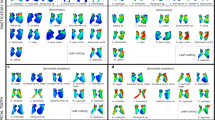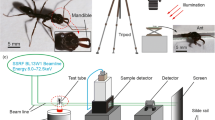Abstract
The ability to grip unhatched eggs is a skill exploited by the ants Harpegnathos venator, as they care their brood in tunneled nests, which is of extreme difficulty to keep the eggs intact while gripping. In this paper we propose a mathematical modeling method to elucidate the mechanism of such a gripping behavior in the ant mandibles. The new method can be subdivided into following steps. As a preliminary, the concavity geometry and mandible kinematics are examined experimentally. Second, coordinate transformation is used to predict the real-time spatial topology of the concavity. Third, we come up with a new method to quantify the workspace required to grip and the contact area between the concavity and ant egg. Our model indicates that the biaxial rotation fashion with specialized concavities can reduce workspace by 40% and increase contact area by 53% on average compared with the uniaxial rotation pattern, which augments success rate of gentle gripping. This methodology may have applications in evaluating mechanical performance in both natural and artificial grippers.
Similar content being viewed by others
References
Negrello F, Mghames S, Grioli G, Garabini M, Catalano M G. A compact soft articulated parallel wrist for grasping in narrow spaces. IEEE Robotics and Automation Letters, 2019, 4, 3161–3168.
Galloway K C, Becker K P, Phillips B, Kirby J, Licht S, Tchernov D, Wood R J, Gruber D F. Soft robotic grippers for biological sampling on deep reefs. Soft Robotics, 2016, 3, 23–33.
Blanes C, Mellado M, Ortiz C, Valera A. Technologies for robot grippers in pick and place operations for fresh fruits and vegetables. Spanish Journal of Agricultural Research, 2011, 9, 1130–1141.
Sinatra N R, Teeple C B, Vogt D M, Parker K K, Gruber D F, Wood R J. Ultragentle manipulation of delicate structures using a soft robotic gripper. Science Robotics, 2019, 4, eaax5425.
Manns M, Morales J, Frohn P. Additive manufacturing of silicon based PneuNets as soft robotic actuators. 51 st CIRP Conference on Manufacturing Systems (CIRP CMS), Stockholm, Sweden, 2018, 72, 328–333.
Tai K, El-Sayed A-R, Shahriari M, Biglarbegian M, Mahmud S. State of the art robotic grippers and applications. Robotics, 2016, 5, UNSP 11.
Monkman G J, Hesse S, Steinmann R, Schunk H. Robot Grippers, John Wiley & Sons, New Jersey, USA, 2007, 212–218.
Yang Y, Chen Y H, Li Y T, Chen M Z Q, Wei Y. Bioinspired robotic fingers based on pneumatic actuator and 3D printing of smart material. Soft Robotics, 2017, 4, 147–162.
Deng H, Zhong G L, Li X F, Nie W. Slippage and deformation preventive control of bionic prosthetic hands. IEEE-ASME Transactions on Mechatronics, 2017, 22, 888–897.
Zhang Y, Deng H, Zhong G L. Humanoid design of mechanical fingers using a motion coupling and shape-adaptive linkage mechanism. Journal of Bionic Engineering, 2018, 15, 94–105.
Paul J. Mandible movements in ants. 21st International Congress of the European-Society-of-Comparative-Physiology-and-Biochemistry, Liege, Belgium, 2001, 131, 7–20.
Zhang W, Li M H, Zheng G B, Guan Z J, Wu J N, Wu Z G. Multifunctional mandibles of ants: Variation in gripping behavior facilitated by specific microstructures and kinematics. Journal of insect physiology, 2019, 120, 103993.
Popov V L, Filippov A E, Gorb S N. Biological microstructures with high adhesion and friction. Numerical approach. Physics-Uspekhi, 2016, 59, 829–845.
Niederegger S, Gorb S, Jiao Y K. Contact behaviour of tenent setae in attachment pads of the blowfly Calliphora vicina (Diptera, Calliphoridae). Journal of Comparative Physiology A, 2002, 187, 961–970.
Gravish N, Wilkinson M, Autumn K. Frictional and elastic energy in gecko adhesive detachment. Journal of the Royal Society Interface, 2008, 5, 339–348.
Peeters C, Hoelldobler B, Moffett M, Ali T M M. “Wall-papering” and elaborate nest architecture in the ponerine ant Harpegnathos saltator. Insectes Sociaux, 1994, 41, 211–218.
Meudec M, Lenoir A. Social responses to variation in food supply and nest suitability in ants (Tapinoma erraticum). Animal Behaviour, 1982, 30, 284–292.
Furneaux P J, Mackay A L. Crystalline protein in the chorion of insect egg shells. Journal of Ultrastructure Research, 1972, 38, 343–359.
Michels J, Gorb S N. Detailed three-dimensional visualization of resilin in the exoskeleton of arthropods using confocal laser scanning microscopy. Journal of Microscopy, 2012, 245, 1–16.
Gronenberg W, Brandao C R F, Dietz B H, Just S. Trap-jaws revisited: The mandible mechanism of the ant Acanthognathus. Physiological Entomology, 1998, 23, 227–240.
Hashemi A, Kalantari M, Kasser M. Direct Solution of the 7 parameters transformation problem. Applied Mathematics & Information Sciences, 2013, 7, 1375–1382.
Yao J L. Rigorous formula for direct calculating parameter in 3D transformation. Bulletin of Surveying and Mapping, 2006, 5, 57–60. (in Chinese)
Alexandru P, Visa I, Alexandru C. Modeling the angular capability of the ball joints in a complex mechanism with two degrees of mobility. Applied Mathematical Modelling, 2014, 38, 5456–5470.
Besl P J, McKay H D. A method for registration of 3-D shapes. IEEE Transactions on Pattern Analysis and Machine Intelligence, 1992, 14, 239–256.
Varady T, Martin R R, Cox J. Reverse engineering of geometric models — An introduction. Computer Aided Design, 1997, 29, 255–268.
Bolle R M, Cooper D B. Bayesian recognition of local 3-D shape by approximating image intensity functions with quadric polynomials. IEEE Transactions on Pattern Analysis and Machine Intelligence, 1984, 6, 418–129.
Chen P, Pavlidis T. Image segmentation as an estimation problem. Computer Graphics and Image Processing, 1980, 12, 153–172.
Jazar R N. Advanced Dynamics: Rigid Body, Multibody, and Aerospace Applications, John Wiley & Sons, New Jersey, USA, 2011, 357–379.
Patek S N, Baio J E, Fisher B L, Suarez A V. Multifunctionality and mechanical origins: Ballistic jaw propulsion in trap-jaw ants. Proceedings of the National Academy of Sciences of the United States of America, 2006, 103, 12787–12792.
Larabee F J, Suarez A V. Mandible-powered escape jumps in trap-jaw ants increase survival rates during predator-prey encounters. PLOS ONE, 2015, 10, e0124871.
Du N, Fan J T, Wu H J, Chen S, Liu Y. An improved model of heat transfer through penguin feathers and down. Journal of Theoretical Biology, 2007, 248, 727–735.
Giulietti F, Tortora P. Optimal rotation angle about a nonnominal Euler axis. Journal of Guidance Control and Dynamics, 2007, 30, 1561–1563.
Aron S, Passera L, Keller L. Queen-worker conflict over sex ratio: A comparison of primary and secondary sex ratios in the Argentine ant, Iridomyrmex humilis. Journal of Evolutionary Biology, 1994, 7, 403–418.
Argatov I, Mishuris G. Frictionless elliptical contact of thin viscoelastic layers bonded to rigid substrates. Applied Mathematical Modelling, 2011, 35, 3201–3212.
Blake A. Practical Stress Analysis in Engineering Design, CRC Press, Florida, USA, 1989, 8–10.
Vincent J F, Clift S E, Menon C. Biomimetics of campaniform sensilla: Measuring strain from the deformation of holes. Journal of Bionic Engineering, 2007, 4, 63–76.
Wang Z K, Zhu M Z, Kawamura S, Hirai S. Comparison of different soft grippers for lunch box packaging. Robotics and Biomimetics, 2017, 4, 10.
Acknowledgment
We appreciate Dr Huizeng Li from Department of Chemistry, Chinese Academy of Sciences who aided us in capturing the CLSM images on the concavity of the ant mandibles. We thank Miss Jiayi Wu from Sun Yat-Sen University for her contribution to drafting figures in this paper. This work was supported by the research grant of Sun Yat-Sen University for Bairen Plan (Grant No. 76200-18841223), and the National Natural Science Foundation of China (Grant No. 51905556).
Author information
Authors and Affiliations
Corresponding author
Electronic supplementary material
Supplementary material, approximately 14.3 MB.
Supplementary material, approximately 3.48 MB.
Supplementary material, approximately 3.15 MB.
Supplementary material, approximately 2.82 MB.
Rights and permissions
About this article
Cite this article
Zhang, W., He, Z., Sun, Y. et al. A Mathematical Modeling Method Elucidating the Integrated Gripping Performance of Ant Mandibles and Bio-inspired Grippers. J Bionic Eng 17, 732–746 (2020). https://doi.org/10.1007/s42235-020-0065-9
Published:
Issue Date:
DOI: https://doi.org/10.1007/s42235-020-0065-9




